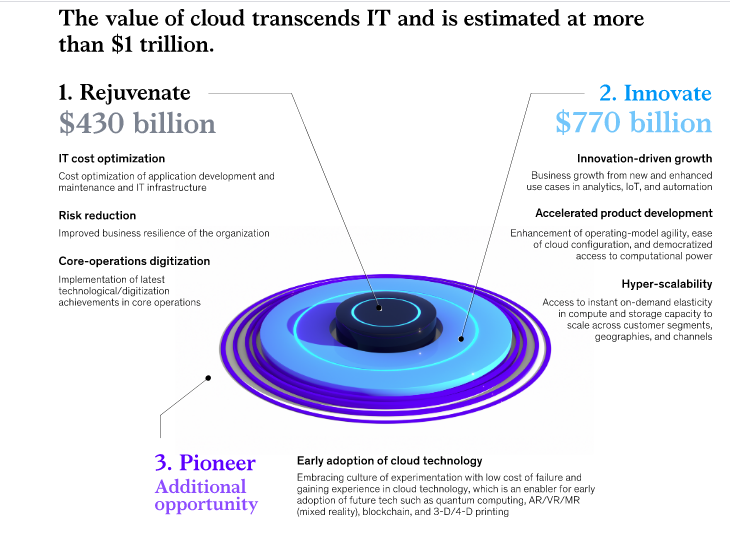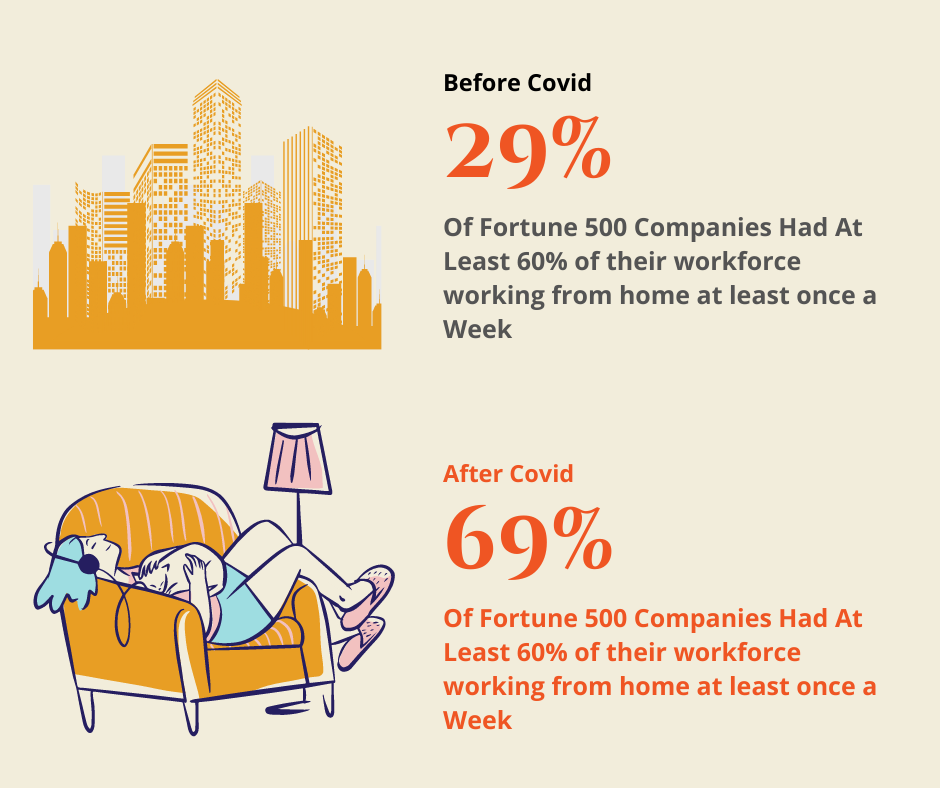2020 and 2021 were defined by the pandemic in so many ways. COVID-19 may have turned our lives, but it could not stop businesses or professionals from growing. Organizations rolled on, coping with the New Normal. While companies relied on digital innovations more than ever, consumers, too, embraced technology more wholeheartedly.
With the world changing so drastically, we have seen the latest technologies emerge ahead of schedule, completely transforming business operations. And there is much more that will likely come in the next few years. Although predicting the future seems like a fool’s errand, CEOs and business owners are, nonetheless, expecting to see some game-changing trends in 2022 and beyond. This article explores five such business-technology trends CEOs need to integrate in the coming year.
So, without further ado, let us explore them one by one for better understanding and effective implementation.
5 Tech-Driven Trends For CEOs
1. Cloud Technology Solutions
Source: McKinsey
Most of you agree that there won’t be any such list of futuristic tech trends without the cloud. Indeed, the cloud would top the list of business-tech innovations.
Before 2020, working on cloud technology was slow and limited as Google and Amazon were the only major cloud solutions companies offering different required services. Then came the pandemic, and cloud-enabled digitization sped up like never before. Businesses realized this technology would keep them afloat in the pandemic market.
It allowed the staff to work from home, gave digital commerce a healthy boost, and took the business platforms to unimaginable heights. Studies show that most CEOs have considered migrating 80% of operations to the cloud in the next few years as it offers data privacy and security.
Number-crunching
- In 2017, the global cloud storage market was worth around $30 billion, and it steadily rose to more than $61 billion in 2020.
- The cloud-computing market is forecast to grow to more than $76 billion in 2021.
- With a CAGR of 26.2 percent for the 2021 to 2028 period, it will balloon to more than $390 billion by 2028.
2. Workplace Transformation and Work culture
Work from home (WFH) has become a key trend in a rapidly changing work environment. While some businesses already had remote working options, COVID-19 has made WFH an urgent need.
As COVID-19 terror continues, most businesses have already considered work-from-home a permanent feature. Some companies have already announced work from home till the middle of 2022. Few others went one step ahead and offered employees to work from home forever! This trend was a concern in the initial stages because of a lack of trust & efficiency. But different work-from-home policies and metrics ensured productivity.
Here are a few ways to make sure remote work is running effectively for your company:
Draft a remote working policy
There is no doubt that remote work has its own set of challenges. But it is the responsibility of the senior management to make sure that employees do not feel burnt out while operations run efficiently. Such policies should have clear-cut rules and regulations covering areas like team collaborations and work-life balance.
Use Tools to make remote work a success
For CEOs, it is important to sign off on crucial acquisitions. In 2021, nothing would be more worth your money than cloud-based communication infrastructures. These are safe and user-friendly. If required, offer your employees a VPN to ensure data safety. Besides, it’s critical to do the needful so that all your employees have access to high-speed internet. It will make sure all virtual collaborations and meetings run without a glitch.
3. Purpose-Driven Digital Transformation
Digital transformation is an approach and strategy to utilize advanced technologies to transform business functions and serve customers better. The methodology has become essential because every firm, regardless of its business operations, relies on technology.
The process a digital transformation company in India uses is the implementation of advanced digital technology and tools to improve existing techniques. This methodology replaces slow, tedious, and manual processes with automated processes. As a result, the way each department works changes dramatically.
To remain ahead & competitive in the digital business environment, CEOs of established companies are focusing on a complete digital transformation journey. With the implementation of IT capabilities, it becomes easy to modernize inflexible and old systems using IT.
4. Prioritize Speedy Project Delivery
Companies will need to adjust their delivery plans to focus on new, tech-driven requirements while maintaining their core values. It could comprise increased social media outreach, more engaging online service for both customers and employees. The most successful companies will deliver projects within the shortest turnaround time and strengthen their networks in even the most difficult situations.
The pace of change is speeding up, making the business landscape more agile and flexible. With speed becoming central to the tech industry, every CEO must make agility their top priority. However, this speed needs to be sustainable. Businesses were comparatively slower in the early months of the pandemic but later picked up the pace with technology trends. In the future, speed needs to be embedded within the business operations. In simple words, speed is just about a unique USP anymore. It has become a must for businesses operating in an ever-changing market.
5. Instill Sustainability in Businesses
Businesses are catching up to consumers’ demands for green initiatives. People can’t afford to ignore rising global issues, and large manufacturing units create most of the pollution. Most of the CEOs are evaluating their business practices and brainstorming ways to generate revenue without harming the environment.
Remote work opportunities are also rising due to business owners realizing the financial and ecological advantages. Employees don’t have to commute daily, and employers can lower energy consumption with fewer people at the workplace. Using social media & digital marketing technologies to promote business is also a popular way to curb paper pollution. Eliminating the use of paper for work orders & tenders is another way to boost green energy initiatives.
Preparing for Tomorrow
The coronavirus brought several businesses to its knees. Technology has been so helpful to enterprises in addressing the global economic crisis. The pandemic worked as a catalyst for new technology trends, and it will continue to drive innovation.
CEOs who leverage these technologies, like digital transformation services, have an opportunity to elevate their business to new heights. Though no CEO can predict the future, you can get ready for every challenge by focusing on these technology trends. Talk to us to make your business prepared for a better tomorrow.


























